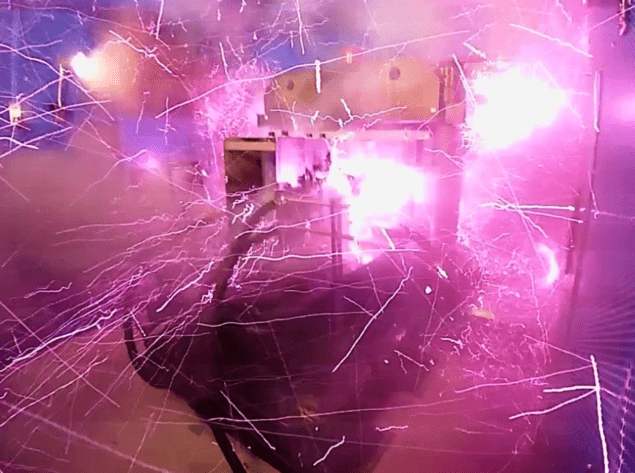
Researchers in Japan have created a long-lasting magnetic field with a strength of 1200 T, which is the strongest controllable field ever produced indoors. In comparison, Earth’s magnetic field is a mere 50 μT and the superconducting magnets on CERN’s Large Hadron Collider deliver about 8 T.
Daisuke Nakamura and his team at the University of Tokyo fine-tuned the technique of electromagnetic flux-compression (EMFC) to achieve the result. Their work could allow for new experiments in solid-state physics and could even boost the performance of nuclear fusion reactors.
Extremely strong magnetic fields are useful for probing the physics of materials. However, creating and maintaining extremely strong fields is notoriously difficult to do. High-power lasers can be used, but this results in fields that last for just nanoseconds.
Another strategy involves first generating a relatively strong field in a metal cylinder (called a liner) by surrounding it with a magnetic coil. By suddenly imploding the liner, the magnetic field it contains is compressed to reach very high strengths.
Explosive technique
Physicists have developed two ways of causing the implosion. One is explosively-driven flux-compression, which use chemical explosives such as TNT. In 2001, physicists in Russia achieved a field strength of 2800 T with this method. However, they had virtually no control over the field during the experiment, and their setup was destroyed. Furthermore, these explosive experiments must be done outdoors.

How to build a super-magnet
Alternatively, EMFC exploits the vast amounts of electrical energy that can be stored inside a bank of capacitors. The liner is surrounded with a specialized-designed coil that is connected to the bank. The capacitors then release a huge current of four million amperes, which is hundreds of times the current of a typical lightning bolt. This induces a strong magnetic force acting inwards towards the axis of the liner – driving a clean and precise implosion. Despite an impressive shower of sparks (see figure), the technique can be carried out safely inside a lab.
Nakamura’s team has been at the forefront of efforts to perfect EMFC technique by tweaking the arrangements of coils and capacitor banks. Indeed, they achieved a field strength of 985 T earlier this year. Yet with further optimization of their setup, the researchers have now delivered a record-breaking indoor field strength of 1200 T. What is more, their field lasted for around 100 µs– thousands of times longer than previous ultra-high fields.
Plasma confinement
“With magnetic fields above 1000 T, you open up some interesting possibilities. You can observe the motion of electrons outside the material environments they are normally within, so we can study them in a whole new light,” comments Nakamura’s colleague Shojiro Takeyama. “This research could also be useful to those working on fusion power generation by confining plasma in a large ring called a tokamak to extract energy from it. This requires a strong magnetic field in the order of thousands of Tesla for a duration of several microseconds. This is tantalizingly similar to what our device can produce.”
The research is described in Review of Scientific Instruments.



